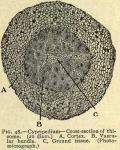84. Cypripedium.—Cypripedium, N. F.
Ladies' Slipper Root.
 (The Cypripediums are rare and endangered orchids. Don't use them unless you grow them yourself. -Henriette)
(The Cypripediums are rare and endangered orchids. Don't use them unless you grow them yourself. -Henriette)
The dried rhizome and roots of Cypripe'dium hirsu'tum Miller, and Cypripedium pubes'cens Wildenow and Cypripedium parviflo'rum Salisbury.
HABITAT.—North America, in swampy regions.

 DESCRIPTION OF DRUG.—A horizontal, somewhat curved rhizome, about the thickness of a quill and 100 mm. (4 in.) or less in length, of a dark brown or light orange-brown color; on the upper side it is closely covered with deeply concave stem-scars about the width of the rhizome, and on the lower side with smooth, simple, wavy rootlets, abruptly descending, varying in length from 100 to 500 mm. (4 to 20 in.); cortical parenchyma thick, wood-bundles and nucleus sheath indistinct; fracture of rhizome short, of roots fibrous; odor somewhat valerian-like, diminishing with age; taste sweetish, bitter, somewhat pungent at the last.
DESCRIPTION OF DRUG.—A horizontal, somewhat curved rhizome, about the thickness of a quill and 100 mm. (4 in.) or less in length, of a dark brown or light orange-brown color; on the upper side it is closely covered with deeply concave stem-scars about the width of the rhizome, and on the lower side with smooth, simple, wavy rootlets, abruptly descending, varying in length from 100 to 500 mm. (4 to 20 in.); cortical parenchyma thick, wood-bundles and nucleus sheath indistinct; fracture of rhizome short, of roots fibrous; odor somewhat valerian-like, diminishing with age; taste sweetish, bitter, somewhat pungent at the last.
Cypripedium parviflorum has the rhizome bent two or three times, almost at right angles, and is of a brighter orange-brown color; the rootlets are shorter and less wavy.
CONSTITUENTS.—Volatile oil (a trace), a volatile acid, resins, tannin, sugar, starch, and fixed oil. The active principle has not yet been isolated, but the virtues of the drug are supposed to reside in the volatile oil and a bitter principle (probably a glucoside). Ash, not more than 12 per cent.
ACTION AND USES.—Diaphoretic, nerve stimulant, and antispasmodic, less powerful than valerian. It is valuable as a substitute for opium in the treatment of children. Dose: 8 to 30 gr. (0.5 to 2 Gm.).

